UPSC Exam > UPSC Notes > History for UPSC CSE > Advent of Aryans & Rig Vedic Period
Advent of Aryans & Rig Vedic Period | History for UPSC CSE PDF Download
Aryans
Aryans were people who were said to speak an archaic Indo-European language and who were thought to have settled in prehistoric times in ancient Iran and the northern Indian subcontinent.
- Aryan is a designation originally meaning “civilized”, “noble”, or “free” without reference to any ethnicity.
- It was first applied as a self-identifying term by a migratory group of people from Central Asia later known as Indo-Iranians (who settled on the Iranian Plateau) and, later, applied to Indo-Aryans (who travelled south to settle northern India).
- They spoke Indo-Iranian, Indo-European or Sanskrit. It is said that Aryans lived East of the Alps (Eurasia), Central Asia, the Arctic region, Germany, and Southern Russia.
Migration of Aryans to India
- There are multiple theories that talk about the original location of Aryans and where they came from, and the time period of their migration into India.
- The migration happened over a period of time, starting around 2000BCE and peaked after the decline of the IVC. Later they migrated westwards, southwards and eastwards.
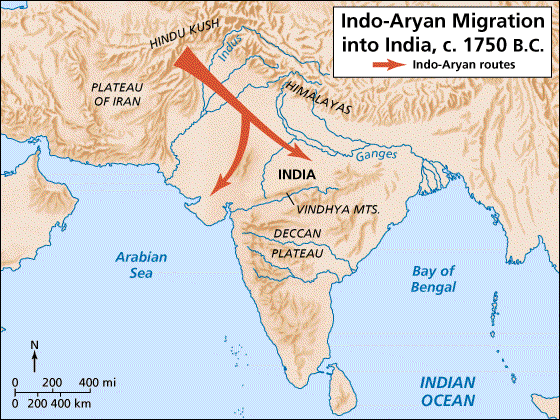 Map showing how Aryans migrated to India
Map showing how Aryans migrated to India
- Some scholars, like Max Müller, propose that the Aryans originated from around the Caspian Sea in Central Asia while others suggest their roots were in the Russian Steppes.
- Bal Gangadhar Tilak was of the opinion that the Aryans came from the Arctic region.
The Vedic Age
The Vedic Age was between 1500 BC and 600 BC. In this time period the Vedas were composed in the northern Indian subcontinent.
The Vedas
The Vedas, are the oldest texts of Hinduism. They are derived from the ancient Indo-Aryan culture of the Indian Subcontinent and began as an oral tradition that was passed down through generations before finally being written in vedic Sanskrit.
The Four Vedas, on which the periods were named after are:
- The Rigveda: The oldest Veda is the Rigveda. It has 1028 hymns called ‘Suktas’ and is a collection of 10 books called ‘Mandalas.’
- Samaveda: Known as the Veda of melodies and chants, Samaveda dates back to 1200-800 BCE. This Veda is related to public worship.
- Yajur Veda: Yajurveda dates back to 1100-800 BCE; corresponding with Samaveda. It compiles ritual-offering mantras/chants. These chants were offered by the priest alongside a person who used to perform a ritual.
- Atharva Veda: This Veda contains hymns many of which were charms and magic spells that are meant to be pronounced by the person who seeks some benefit, or more often by a sorcerer who would say it on his or her behalf.
Question for Advent of Aryans & Rig Vedic PeriodTry yourself:The Early Vedic Period is named after which of the following Vedas?
View Solution
- The Vedic period or Vedic age is the next major civilization that occurred in ancient India after the decline of the Indus Valley Civilization by 1400 BC.
The Vedic period can further be divided into 2 parts: - Early Vedic Period (1500-1000 BC)
- The Later Vedic Period (1000-600 BC)
Early Vedic Period or The Rig Vedic Period
Since the Rigveda is considered the oldest of all the vedas, the Early Vedic Period i,e. 1800–1500 BCE is also called the Rigvedic period.
Features of the Rig Vedic Period
Political Structure
- The political units during the Rig Vedic or the early Vedic period comprised of Grama (village), Vis (clan), and Jana (people).
- Aryans were organized into tribes rather than kingdoms. The chief of a tribe was called a Rajan.
- The autonomy of the Rajan was restricted by the tribal councils called Sabha and Samiti.
- These two bodies partly governed the tribe. The Rajan could not accede to the throne without their approval.

Form of Government
- Monarchy was the normal form of Government.
- Kingship was hereditary. But there was a sort of hierarchy in some states, several members of the royal family exercising the power in common.
- There were references to a democratic form of government and their chiefs were elected by the assembled people.
The King
- The kingdom was small in extent. The king enjoyed a position of pre-eminence in the tribe. Kingship was hereditary.
- He was appointed by the priest as king in the Abhisheka Ceremony. He wore gorgeous robes and lived in a splendid palace, gaily decorated than a common building.
- The king had the duty to protect the life and property of his people.
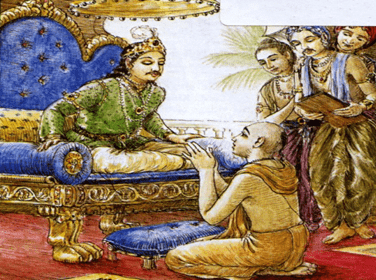
- The sacred duty of the king was the protection of the tribes and the territory and the maintenance of priests for the performance of sacrifices.
- Maintenance of law and order was his principal duty. He maintained justice with the help of Purohits. He collected tributes known as “Bali” in kind from his subjects.
Question for Advent of Aryans & Rig Vedic PeriodTry yourself:What form of government existed during the early Vedic period?
View Solution
Officials
- In the work of administration, the king was assisted by a number of functionaries like the purohita (priest), the Senani (general) the Gramani (village headman).
- Purohit was the most important officer of the state.
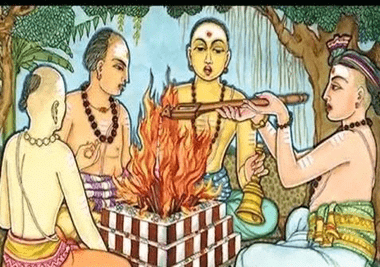 Purohit performing rituals
Purohit performing rituals
The Army
- The army mainly consisted of Patti (infantry) and Rathi's (chariots). The weapons used by the soldiers were bows, arrows, swords, axes and spears.
- These weapons were made of iron. The soldiers were organized into units known as Sardha, Vrata and gala.
 Ancient Indian warfare
Ancient Indian warfare
Popular Assemblies
- The Rig Veda mentions the names of two popular assemblies known as Sabha and Samiti.
- Though the king enjoyed substantial power yet he was not an autocrat. In the work of administration, he consulted these two bodies and acted according to their decision. Sabha was a select body of elders.
- The head of the sabha was known as ‘Sabhapati’.
Question for Advent of Aryans & Rig Vedic PeriodTry yourself:Who was the most important officer of the state?
View Solution
Economic Structure
- The concept of Varna, along with the rules of marriage, was made quite stiff. Social stratification took place, with the Brahmins and the Kshatriyas being considered higher than the Shudras and the Vaisyas.
- Cows and bulls were accorded religious significance. Aryans followed a mixed economy i.e. pastoral and agricultural in which cattle played a predominant part.
- The standard unit of exchange was Cow. The world's oldest currency coins were issued in ancient India during the Vedic period and were called Nishka and Mana. Nishka coins were small gold units of definite weight.
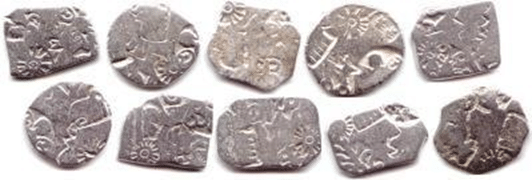 Coins of Vedic Period
Coins of Vedic Period
Occupation
- Apart from agriculture and animal husbandry Aryans had also other occupations. Weaving was the most important occupation.
- We learned about the weavers of wool and cotton together with the workers in the subsidiary industries of dyeing and embroidery.
- The carpenters built houses, chariots, wagons and supplied household utensils and furniture.
Trade and Commerce
- There was trade and maritime activity. Sometimes, traders made the journey to distant lands for larger profits in trade.
- There was probably commercial intercourse with Babylon and other countries in Western Asia. The principal media of trade was barter.
- The cow was used as a unit of value. Gradually pieces of gold called “nishka” were used as means of exchange.
- Trade and commerce were regulated and managed by a group of people called “Pani”.Question for Advent of Aryans & Rig Vedic PeriodTry yourself:Which animal was considered a symbol of wealth and prosperity?View Solution
Social Structure
- The family was regarded as the social and political unit. It was the nucleus of the social life of the early Aryans.
- The father was the head of the family and he was known as “grihapati”. The Aryans had joint families. The father had great authority over the children.
Position of Women
- In the early Vedic age women enjoyed an honoured place in society.
- The wife was the mistress of the household and had authority over the slaves. In all religious ceremonies, she participated with her husband.
- The Prartha system was not prevalent in society. The Sati system was also not prevalent during this period
- The Rig-Veda mentions the names of some learned ladies like Viswavara, Apala and Ghosa who composed mantras and attained the rank of Rishis. The girls were married after attaining puberty.
- The practice of ‘Swayamvara’ was also prevalent in society. Monogamy was the general practice. Remarriage of widows was permitted.
Education
- In the Rig-Vedic age great importance was given to education.
- There were Gurukuls which imparted education to the disciples after their sacred-thread ceremony.
- Entire instruction was given orally. The Vedic education aimed at proper development of mind and body.
- The disciples were taught about ethics, the art of warfare, the art of metal and the concept of Brahma and philosophy, and basic sciences like agriculture, animal husbandry, and handicrafts.
 Gurukul
Gurukul
Caste System
- In the early Vedic age there was no caste system. Members of the same family took to different arts, crafts, and trades.
- People could change their occupation according to their needs or talents. There was hardly any restriction in intermarriage, change of occupation.
- There was no restriction on taking food cooked by the Sudras.
Agriculture
- References in the Rig-Veda shows that agriculture was the principal occupation of the people.
- They ploughed the field by means of a pair of oxen. Rig-Veda even mentions that 24 oxen were attached to a ploughshare at the same time to plough the land.
- The ploughed land was known as Urvara or Kshetra. Water was supplied into the fields by means of an irrigation canal.
- The use of manure was known to them.
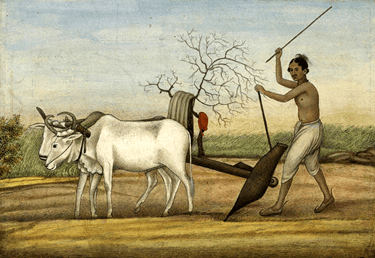 Farming
Farming - Barley and wheat were mainly cultivated. Cotton and oilseeds were also grown. Rice was perhaps not extensively cultivated. Agriculture was their main source of income.
Domestication of Animals
- Besides agriculture, cattle breeding was another means of living. There are prayers in the Vedas for Gosu (cattle).
- Cows were held in great respect. Cows were symbols of the wealth and prosperity of the Aryans. Sometimes cows were the medium of exchange.
- The Aryans had also domesticated animals like horse, ox, dog, goat, sheep, buffalo and donkey.
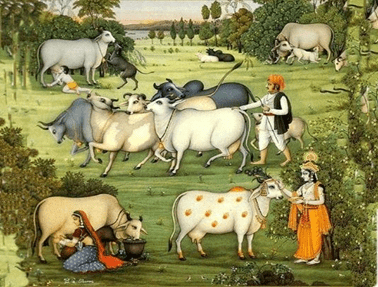 Cattle Rearing
Cattle Rearing
Transport and Communication
- The chief means of transport by land were rath (Chariots) and wagons drawn by horses and oxen.
- Riding on horseback was also in vogue.
Religion
- Rishis, composers of the hymns of the Rig Veda, were considered to be divine. The main deities were Indra, Agni (the sacrificial fire), and Soma.
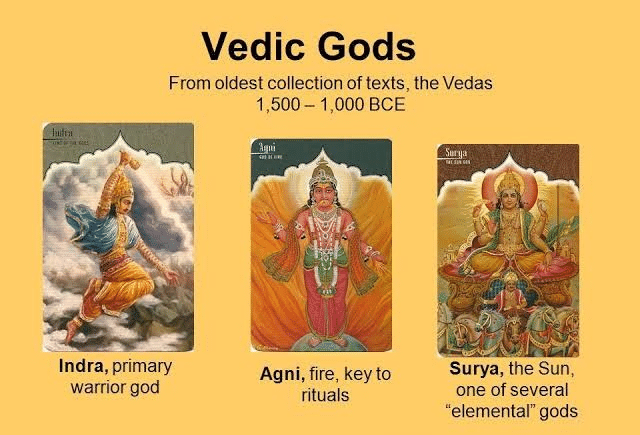 Gods mentioned in Rig Veda
Gods mentioned in Rig Veda - People also worshipped Mitra-Varuna, Surya (Sun), Vayu (wind), Usha (dawn), Prithvi (Earth) and Aditi (the mother of gods). Early Vedic religion focused on rituals, hymns, and nature worship.
The document Advent of Aryans & Rig Vedic Period | History for UPSC CSE is a part of the UPSC Course History for UPSC CSE.
All you need of UPSC at this link: UPSC
|
110 videos|652 docs|168 tests
|
FAQs on Advent of Aryans & Rig Vedic Period - History for UPSC CSE
| 1. How did the Aryans migrate to India? |  |
Ans. The Aryans are believed to have migrated to India from Central Asia around 1500 BCE through the passes in the northwestern mountains.
| 2. What is the significance of the Vedic Age in Indian history? |  |
Ans. The Vedic Age marked the beginning of the Indo-Aryan civilization in India and laid the foundation for Hinduism and other cultural aspects of Indian society.
| 3. What are the Vedas and their importance during the Vedic Age? |  |
Ans. The Vedas are ancient sacred texts of Hinduism composed in Sanskrit. They are considered the oldest scriptures of Hinduism and played a crucial role in shaping religious and philosophical beliefs during the Vedic Age.
| 4. How was the political structure during the Rig Vedic Period? |  |
Ans. The political structure during the Rig Vedic Period was tribal in nature, with tribes being led by chiefs or kings who were chosen based on their prowess in battle and leadership abilities.
| 5. What were the main features of the social structure in the Early Vedic Period? |  |
Ans. The social structure in the Early Vedic Period was hierarchical, with the society divided into four varnas (castes) - Brahmins (priests), Kshatriyas (warriors), Vaishyas (merchants), and Shudras (laborers).
Related Searches

















